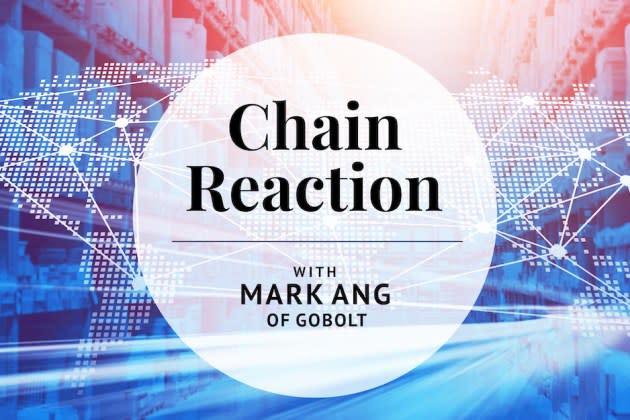Chain Reaction: Mark Ang of GoBolt on Leveraging AI

Chain Reaction is Sourcing Journal’s discussion series with industry executives to get their take on today’s logistics challenges and learn about ways their company is working to keep the flow of goods moving. Here, Mark Ang, CEO and co-founder of GoBolt, discusses how the sustainable fulfillment and last-mile 3PL leverages advanced technology for speedier, lower cost shipping and how fashion can streamline returns.

Name: Mark Ang
More from Sourcing Journal
AI's Role in Overcoming Post-Pandemic Supply Chain Challenges
Google Launches Updated AI Tools for a Personalized Shopping Experience
Title: CEO and Co-Founder
Company: GoBolt
What is GoBolt?
GoBolt is building the world’s largest sustainable supply chain network. Today, we’re driving this goal with three major initiatives. First, we’re rounding out our e-commerce fulfillment solution by doubling down on reverse logistics. We’re also electrifying our fleet to conduct as many carbon-neutral deliveries as possible. Lastly, we’re optimizing our network infrastructure to better serve our customers, ensuring consistency in our fulfillment and last-mile delivery processes as we expand.
What industries do you primarily serve? Which industry do you think has the most to teach fashion about improving their supply chain logistics?
We store, pick, pack, ship and deliver furniture, appliances, fitness equipment and other products for home and garden brands, as well as fashion, apparel and travel-related items. We’re also seeing an uptick in our electronics and pharmaceutical products categories.
Fashion experiences high return rates, posing significant challenges in determining optimal inventory levels and handling returned items efficiently. To address these challenges, fashion can draw inspiration from the lean inventory practices employed by the automotive and fast-food industries. By adopting similar frameworks and leveraging artificial intelligence (AI) for demand planning, fashion can reduce overstock and mitigate the need for clearance sales. And with strategic partnerships and technology that digitizes standard operating procedures (SOP) and utilizes guided workflows, the industry can streamline its returns processing.
When it comes to creating efficiencies, there are quick wins and longer plays. What are a few things your company is doing to help its partners succeed on both fronts?
We are prioritizing our network design to optimize cost management and efficiency for our e-commerce merchants. Leveraging our zone-skipping network, last-mile division and commitment to net-zero deliveries, we are consolidating shipments and orchestrating orders, helping deliver immediate cost savings to our partners. That’s our quick win.
Our longer play is in inventory planning. With AI tools and strategic partnerships, we’re optimizing our inventory placement based on factors like geographical location, product profile and demand patterns. By leveraging AI to analyze and predict these variables, we’re working to reduce shipping costs and improve delivery speed.
What is the one thing brands and retailers could be doing to make better use of technology to improve logistics?
Leveraging AI in their planning processes would enable faster decision-making and reduced overhead. Given we’re in the early innings of AI, more could be done to bring supply chain executives together to share best practices. For example, AI can be used to simulate the effects of supply chain transformations like relocating a distribution center or adjusting product offerings. However, until there’s social proof, taking the first step will be exclusive to a small cohort of early adopters.
What is the main thing brands and retailers could do right now that would immediately improve logistics?
Rather than adhering to the pressure of next-day or two-day shipping, brands and retailers can prioritize economic efficiency and customer satisfaction by offering realistic and accurate delivery options that are aligned with their consumers’ preferences.
When it comes to supply chain logistics challenges, there are things companies can fix and things that are beyond their control. How can the former help the latter?
Companies can create their own logistics problems with poor planning. Take over purchasing, for example. It ties up cash in slow-moving products, increases storage costs and results in the disposal of products. Proactive and smart planning, which is directly within their control, can alleviate these issues by optimizing inventory levels to align with demand patterns, which may be beyond their control.
What is your company doing to make the movement of goods more sustainable?
First, we operate more than a dozen strategically positioned facilities across North America. This gives us great coverage to zone skip and forward place products, where we consolidate the bulk shipment of products to ultimately move products closer to their final destinations. Second, as our name suggests, we are actively working toward achieving net-zero deliveries across both our big-and-bulky and parcel divisions. Our use of electric vehicles is our primary net-zero strategy.
What logistic challenges do you think the industry is currently facing?
The industry is grappling with consolidation. On one hand, it raises concerns about capital allocation and market dynamics. On the other hand, it offers efficiency and scale benefits. But the influx of capital during the Covid-19 pandemic is now trying to find an exit, and this could result in suboptimal outcomes for brands, including diminished service quality, limited innovation, reduced competition and ultimately, higher prices.
Are you optimistic about the state of supply chains in the next few years?
I’m generally a very optimistic person, so I’m quite excited about the future of the supply chain. We’ve seen the emergence of new players in the market who have demonstrated remarkable resilience and innovation, showcasing what’s achievable when creative minds come together.

